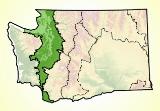 © Pete Saloutos/Panoramic Images (Washington Title Image Large)
© Pete Saloutos/Panoramic Images (Washington Title Image Large)

Puget Trough Human Impact
More than three-fourths of Washington’s human population is concentrated in the Puget Trough ecoregion. A number of human activities and land uses adversely affect its biodiversity.
In marine and nearshore habitats, some of the most significant problems include:
- Shoreline modifications. Bulkheading, dredging, diking, and filling lead to loss of native habitat. Changes in sediment and wave energy alter beaches and subtidal areas.
- Environmental contaminants. In sediments and in water, these threaten the health of wildlife and people alike.
- Marine invasive non-native species. They threaten ecological stability. Once established, they are difficult and expensive to control and virtually impossible to eradicate.
- Habitat loss and fragmentation. This affects native plants and animals in forests, in grasslands and oak woodlands, and in riparian and wetland habitats.
- Management practices. Customary management practices have frequently degraded the wildlife habitat value of working forests and farms. New management methods and incentives to “grow habitat” help conserve biodiversity of these important non-urbanized areas.
- Terrestrial invasive non-native species. These pose threats to both the diversity and abundance of native plant and animal species.
The political will and creativity of the people who inhabit the Puget Trough ecoregion will be key to finding solutions to these issues.
For details of this ecoregion within Washington, click a subheading in the left column.
View the more general description of this ecoregion in North America



